Book contents
- Frontmatter
- Contents
- Preface
- List of abbreviations
- Part I Computing platforms
- Chapter 1 Enterprise computing: a retrospective
- Chapter 2 The internet as a platform
- Chapter 3 Software as a service and cloud computing
- Chapter 4 Enterprise architecture: role and evolution
- Part II Cloud platforms
- Part III Cloud technologies
- Part IV Cloud development
- Part V Software architecture
- Part VI Enterprise cloud computing
- References
- Index
Chapter 1 - Enterprise computing: a retrospective
Published online by Cambridge University Press: 06 December 2010
- Frontmatter
- Contents
- Preface
- List of abbreviations
- Part I Computing platforms
- Chapter 1 Enterprise computing: a retrospective
- Chapter 2 The internet as a platform
- Chapter 3 Software as a service and cloud computing
- Chapter 4 Enterprise architecture: role and evolution
- Part II Cloud platforms
- Part III Cloud technologies
- Part IV Cloud development
- Part V Software architecture
- Part VI Enterprise cloud computing
- References
- Index
Summary
INTRODUCTION
By ‘enterprise computing’ we mean the use of computers for data processing in large organizations, also referred to as ‘information systems’ (IS), or even ‘information technology’ (IT) in general. The use of computers for enterprise data processing began in the 60s with the early mainframe computers. Over the years enterprise computing paradigms have changed dramatically with the emergence of new technology: The advent of the PC in the 80s led to the replacement of large mainframe computers by client-server systems. The rise of the internet in the 90s saw the client-server model give way to web-based enterprise applications and customer-facing e-commerce platforms.
With each of these advances, enterprise systems have dramatically improved in terms of scale and ubiquity of access. At the same time their complexity, and consequently cost, has increased as well: Trillions of dollars are spent world-wide on information technology, including hardware and software purchases as well as application development (in-house or outsourced). It is also estimated that enterprises spend between two and ten percent of their revenues on IT.
Now, cloud computing offers the potential for revolutionizing enterprise computing once more, this time by transforming computing itself into a utility that can be accessed over the internet. In his recent book The Big Switch, Nicholas Carr compares the possible ramifications of such a change to the creation of the electricity grid in the early twentieth century.
- Type
- Chapter
- Information
- Enterprise Cloud ComputingTechnology, Architecture, Applications, pp. 3 - 15Publisher: Cambridge University PressPrint publication year: 2010

